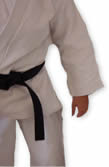
Suparimpei
Part 1
(“108 Hands”) is derived from 36 x 3 = Eye, ear, nose, tongue, body, and spirit; times color, voice, taste, smell, touch, justice equals 36
Times 3, this represents Past, Present, and Future.
108 have a special significance in Buddhism. It is believed that man has 108 evil passions, and so in Buddhist temples on December 31st, at the stroke of midnight, a bell is rung 108 times to drive away those spirits.
Another name for this kata is Pichurin. Originally in China there were three variations of Suparempei, the Dai, Chu, Sho variations. The kata practiced today is the sho variation. Suparempei is the most difficult kata in Goju Ryu.
Part 2
The Kata was introduced to Okinawa from the Fukien Province in China over 100 years ago. The Kata involves fast and slow complex movements with harmonized breathing control. The most advanced of the 13 Goju-ryu katas. Contains 108 fighting movements symbolizing, it is said, the 108 desires/temptations (violations) of man, as listed in Buddhist doctrines. However, as there are considered 108 major stunning and killing points on the human body it has been said that this Kata has its origins from an acupoint school originally established by Feng-Yiquan. Additionally, Susruta-Samhita was an Indian medical Sastra of the 2nd century AD. Susruta wrote the book to give information highlighting the 108 'vulnerable points' on the body.
